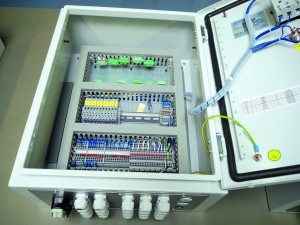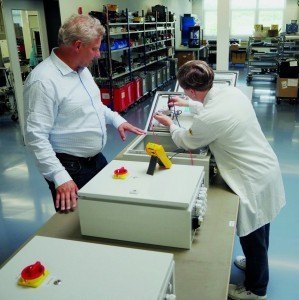A new method for local air and climate improvement is proving its worth in numerous metropolitan areas: so-called CityTrees, multi-shaped street furniture with a biologically active filter and cooling medium. After initial technical problems, the manufacturer's cooperation with an electronics system provider from Saxony-Anhalt ensured functionality and Europe-wide success.
 View inside a CityTree control unitMosshas the natural ability to bind and break down pollutants and evaporate large amounts of moisture. Green City Solutions GmbH uses this property to reduce air pollution with particulate matter,CO2 and other harmful substances locally, increase the oxygen content and reduce summer heat. To this end, the company, which was founded in 2014, plants the natural filter medium on the vertical surfaces of its innovative street furniture. The first CityTrees were launched with passive moss filters. However, practical experience quickly revealed the weaknesses of this approach. Without constant, precise condition monitoring and active influence on the climate-active biomass, it cannot be optimally supplied. Failures, a reduced environmental impact and skepticism among municipal users were the result. There was also criticism of the high energy consumption of the systems and the considerableCO2 equivalent. In 2018, GCS Managing Director Peter Sänger was therefore urgently looking for an electronics expert with IoT expertise to ensure continuous, dynamic and energy-optimized remote control and demand-based supply of the moss-covered filter fields of each CityTree. KD Elektroniksysteme from Zerbst (Saxony-Anhalt), which specializes in customer-specific development projects, provided this increase in expertise.
View inside a CityTree control unitMosshas the natural ability to bind and break down pollutants and evaporate large amounts of moisture. Green City Solutions GmbH uses this property to reduce air pollution with particulate matter,CO2 and other harmful substances locally, increase the oxygen content and reduce summer heat. To this end, the company, which was founded in 2014, plants the natural filter medium on the vertical surfaces of its innovative street furniture. The first CityTrees were launched with passive moss filters. However, practical experience quickly revealed the weaknesses of this approach. Without constant, precise condition monitoring and active influence on the climate-active biomass, it cannot be optimally supplied. Failures, a reduced environmental impact and skepticism among municipal users were the result. There was also criticism of the high energy consumption of the systems and the considerableCO2 equivalent. In 2018, GCS Managing Director Peter Sänger was therefore urgently looking for an electronics expert with IoT expertise to ensure continuous, dynamic and energy-optimized remote control and demand-based supply of the moss-covered filter fields of each CityTree. KD Elektroniksysteme from Zerbst (Saxony-Anhalt), which specializes in customer-specific development projects, provided this increase in expertise.
By adapting and networking various system components, the new partner developed a completely new system of complex switching and control devices within a very short space of time, converting the vertical gardens from passive to active air filters. A specially developed circuit board in the control cabinet of each CityTree acts as a head unit and regulates all processes in the individual filter modules. It monitors and controls the fill level of the water tank, checks the temperature in conjunction with an electronic controller unit installed in each module and the humidity there, which varies depending on the position of the sun and the intensity of the UV radiation, and then controls the irrigation valves as required, among other things. At the same time, its sensor system measures the fine dust load on the individual surfaces, records the current particle size to be filtered and regulates the optimum air flow by means of integrated fans for each module. Thanks to the constantly available wealth of data on the condition of the filter material, the networked system can react very dynamically to changes in the ambient conditions.
State-of-the-art sensor technology monitors the organic filter medium
 Final inspection of a CityTree control cabinet at KD Thedata recorded locally by various sensors is transmitted from the individual controllers to the head unit via a bus system. This is where the gateway, another KD in-house development, comes into play: Bidirectional communication with the central server of Green City Solutions takes place via the gateway's API interface. If it requests information on any climate tree worldwide, the gateway delivers it via the cloud in near real time for processing at the GCS headquarters in Bestensee, south of Berlin. The resulting control commands are sent back to the bio-filter's actuators just as quickly.
Final inspection of a CityTree control cabinet at KD Thedata recorded locally by various sensors is transmitted from the individual controllers to the head unit via a bus system. This is where the gateway, another KD in-house development, comes into play: Bidirectional communication with the central server of Green City Solutions takes place via the gateway's API interface. If it requests information on any climate tree worldwide, the gateway delivers it via the cloud in near real time for processing at the GCS headquarters in Bestensee, south of Berlin. The resulting control commands are sent back to the bio-filter's actuators just as quickly.
According to Managing Director Ralf Kleinodt, KD was faced with a complex challenge with regard to a new generation of CityTrees that is currently being developed and the research and development work that is still ongoing. The IoT had to be transformed into an 'Internet of living things'. In particular, accurately recording the properties of the organic filter medium and combining them with state-of-the-art sensors and active irrigation and ventilation technology was a demanding task. Kleinodt speaks of an "agile development process with constant sprints". As part of the "continuous sequence of design optimization", the energy balance of the overall system was also significantly improved by further developing the fans: their power consumption was reduced by a factor of 5 compared to the previous solution. The project received scientific support from the Leibniz Institute for Tropospheric Research in Leipzig and the Dresden Institute of Air Handling and Refrigeration.
According to Kleinodt, the close cooperation with HEB industrieelektronik from the region also contributed to the success of the project. The EMS service provider, which specializes in electronic assemblies, devices and systems, delivered quality under constant time pressure and ensured the assembly of the controller units, among other things.
Edge computing allows climate trees to thrive dynamically
KD Elektroniksysteme itself used its two decades of expertise in the development and implementation of complete IoT systems for the interdisciplinary project. It was incorporated into the project planning and production of all switching and control equipment, PCB development and programming, as well as sensor design and connection, and the switching and installation of distributed networks, including connection to the client's cloud system.
Even the construction, assembly and installation of the control cabinets were carried out in-house. The company is particularly proud of the decentralized data acquisition and processing in the controllers of the individual moss fields. The client had originally envisaged dedicated lines with a continuous data flow to the server. However, the Zerbst-based company opted for a more sophisticated and efficient conceptual approach: with their solution, the enormous flood of information from the large number of data measuring points is analyzed by the head unit on site, values are averaged and a current balance is drawn up. If, for example, 'everything is in the green', only this information is recorded every second, collected and sent to the cloud as a data package together with others at intervals of 20 or 30 seconds. In the event of a problem, such as a lack of moisture, the system transmits more detailed information on the critical value and thus enables a targeted, immediate response. All parameters of these complex processes can be freely adjusted at any time via the cloud using a config file.
Decisive advantages of KD's edge computing solution compared to a continuous data flow without upstream analytics: The volume of data traffic between the individual CityTree and the operator's central computer shrinks massively, thus also reducing traffic costs and energy consumption in the server. In addition, the supply system does not collapse if the data connection to the central computer is temporarily cut: the local algorithm then regulates the behavior of the living system in emergency mode.
Air quality for metropolitan areas and event locations
 CityTrees also ensure better air quality in LisbonMain users ofthe multifunctional innovative service have so far been local authorities, including major cities such as London, Paris, Brussels and Amsterdam, as well as large German cities such as Hamburg, Berlin, Bonn, Jena and Stuttgart. However, the system is also suitable for event locations, companies, schools or authorities and any other location where local air quality is particularly important.
CityTrees also ensure better air quality in LisbonMain users ofthe multifunctional innovative service have so far been local authorities, including major cities such as London, Paris, Brussels and Amsterdam, as well as large German cities such as Hamburg, Berlin, Bonn, Jena and Stuttgart. However, the system is also suitable for event locations, companies, schools or authorities and any other location where local air quality is particularly important.
To refinance the CityTrees, which cost around €40,000 each, the latest Generation 3 is equipped with a digital 'wall map' for rental to advertising customers or for local information and dialog systems. The precise data available in real time on the intensity of local UV radiation, air temperature or particulate pollution at each location can also be used by third-party customers, saving them the cost of their own measuring points. And, of course, the climate trees are also suitable for taking on additional technical functions - for example by equipping them with technology for the expansion of the 5G network.
In future, KD Elektroniksysteme will also use the knowledge and experience gained from the project in other areas, such as the networking and IoT connection of control devices in building management systems or the development of complex circuit board solutions for control cabinet-based control and regulation systems, including their complete production - also in collaboration with "exciting start-up partners", says Ralf Kleinodt. Such joint projects are often particularly challenging, but offer enormous development potential for both sides.


